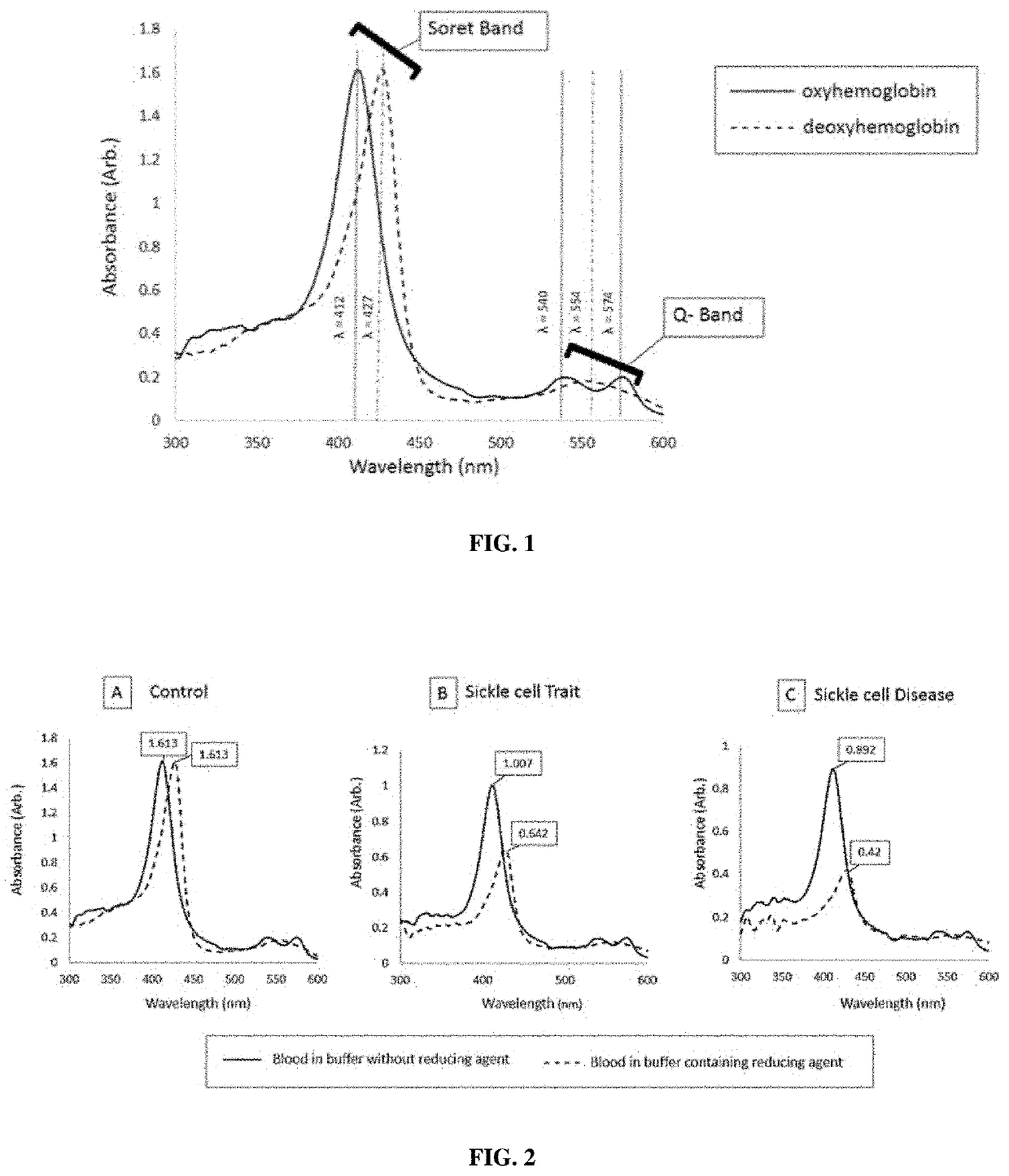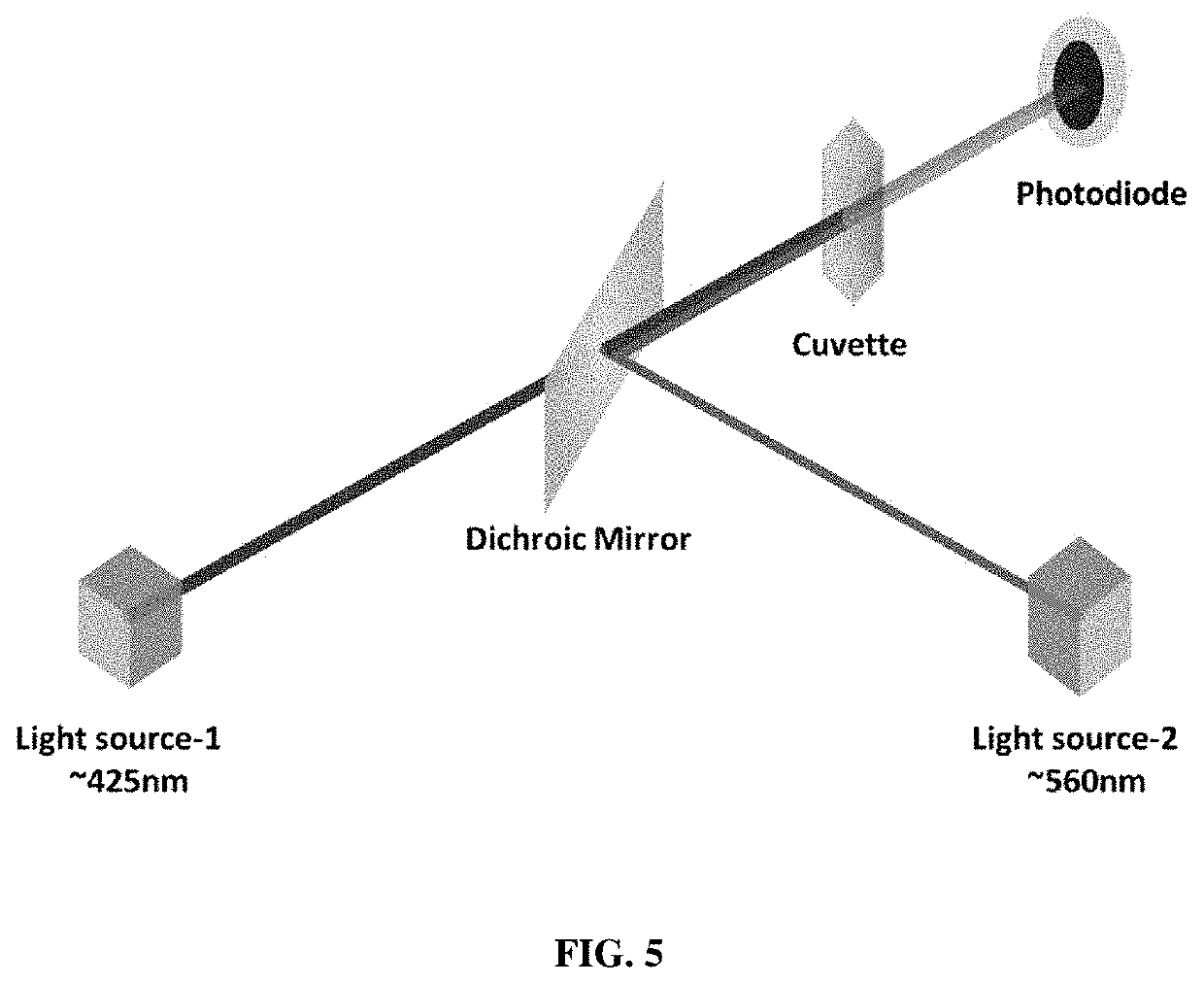Methods for Identifying Haemoglobin S or C in a Biological Sample and Kits Thereof
a technology of haemoglobin and kit, which is applied in the field of identifying the presence or absence of haemoglobin s (hbs) and/or or haemoglobin c (hbc) in a blood sample, can solve the problems of destroying organs, reducing the oxygen-rich blood supply of tissues, and polymerizing defective haemoglobin proteins within the rb
- Summary
- Abstract
- Description
- Claims
- Application Information
AI Technical Summary
Benefits of technology
Problems solved by technology
Method used
Image
Examples
example 1
tion of Threshold Values Using the Ratio Method (Known Samples)
[0136]In this study, known samples were used to analyze the absorption at 427 nm and 555 nm under deoxygenated conditions using 2.365M phosphate buffer.
[0137]Sample Collection:
[0138]Venous blood samples were collected in K2EDTA coated collection tubes and stored at 2° C.-8° C. until the tests were carried out.
[0139]Buffer Preparation:
[0140]Phosphate buffer of 2.365M concentration was prepared by adding monobasic salt 1.178 M (160.3 g / L) and dibasic salt 1.187 M (206.8 g / L). Saponin and sodium metabisulfite at 2% final concentration were added to the buffer. The freshly prepared buffer was used for testing within 4 hours of preparation.
[0141]Testing:
[0142]5 μL of blood sample was added to the tube containing 1 mL of buffer, mixed well and incubated at room temperature for 15 minutes. The sample-buffer mixture loaded into a glass cuvette of 2 mm pathlength and measured the optical absorption spectrum using a spectrophotome...
example 2
tion of Threshold Values Using the Ratio Method (Known Samples)
[0147]In this study, known samples were used to analyze the absorption at 427 nm and 555 nm under deoxygenated conditions using 2.083M phosphate buffer.
[0148]Sample Collection:
[0149]Venous blood samples were collected in K2EDTA coated collection tubes and stored at 2° C.-8° C. until the tests were carried out.
[0150]Buffer Preparation:
[0151]Phosphate buffer of 2.083 M concentration was prepared by adding Monobasic salt 1.178 M (160.3 g / L) and dibasic salt 0.905 M (156.2 g / L). Saponin and sodium metabisulfite at 2% final concentration were added to the buffer. The freshly prepared buffer was used for testing within 4 hours of preparation.
[0152]Testing:
[0153]5 μL of blood sample was added to the tube containing 1 mL of buffer, mixed well and incubated at room temperature for 15 minutes. The sample-buffer mixture loaded into a glass cuvette of 2 mm pathlength and measured the optical absorption spectrum using a spectrophotom...
example 3
of Blood Samples Using the Ratio Method (Blind Study)
[0157]In this study, unknown samples were analyzed using 2.365M phosphate buffer to identify the presence or absence of HbS and the presence or absence of SCD or SCT.
[0158]Sample Collection:
[0159]Venous blood samples were collected in K2EDTA coated collection tubes and stored at 2° C.-8° C. until the tests were carried out.
[0160]Buffer Preparation:
[0161]Phosphate buffer of 2.365M concentration was prepared by adding monobasic salt 1.178 M (160.3 g / L) and dibasic salt 1.187 M (206.8 g / L). Saponin and sodium metabisulfite at 2% final concentration were added to the buffer. The freshly prepared buffer was used for testing within 4 hours of preparation.
[0162]Testing:
[0163]5 μL of blood sample was added to the tube containing 1 mL of buffer, mixed well and incubated at room temperature for 15 minutes. The sample-buffer mixture loaded into a glass cuvette of 2 mm pathlength and measured the optical absorption spectrum using a spectropho...
PUM
| Property | Measurement | Unit |
|---|---|---|
| wavelength | aaaaa | aaaaa |
| wavelength | aaaaa | aaaaa |
| wavelength | aaaaa | aaaaa |
Abstract
Description
Claims
Application Information
 Login to View More
Login to View More - R&D Engineer
- R&D Manager
- IP Professional
- Industry Leading Data Capabilities
- Powerful AI technology
- Patent DNA Extraction
Browse by: Latest US Patents, China's latest patents, Technical Efficacy Thesaurus, Application Domain, Technology Topic, Popular Technical Reports.
© 2024 PatSnap. All rights reserved.Legal|Privacy policy|Modern Slavery Act Transparency Statement|Sitemap|About US| Contact US: help@patsnap.com










